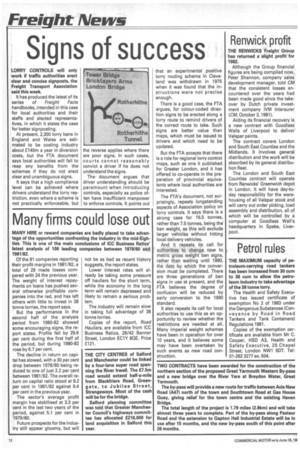Signs of success
Page 14

If you've noticed an error in this article please click here to report it so we can fix it.
LORRY CONTROLS will only work if traffic authorities erect clear and concise signposts, the Freight Transport Association said this week.
It has produced the latest of its series of Freight Facts handbooks, intended in this case for local authorities and their staffs and elected representatives, in which it states the case for better signposting.
At present, 2,300 lorry bans in England and Wales are estimated to be costing industry about £140m a year in diversion costs, but the FTA document says local authorities will fail to reap any benefits from the schemes if they do not erect clear and unambiguous signs.
It says that a high compliance level can be achieved where drivers understand the lorry restriction, even where a scheme is not practically enforceable, but the reverse applies where there are poor signs. In such cases, courts cannot reasonably convict a driver if he does not understand the signs.
The document argues that driver understanding should be paramount when introducing controls, especially as police often have insufficient manpower to enforce controls. It points out that an experimental positive lorry routing scheme in Cleveland was withdrawn in 1975 when it was found that the instructions were not precise enough.
There is a good case, the FTA argues, for colour-coded direction signs to be erected along a lorry route to remind drivers of the correct route to take. Such signs are better value than maps, which must be issued to drivers and which need to be updated.
But the FTA accepts that there is a role for regional lorry control maps, such as one it published for Greater London, and it has offered to co-operate in the preparation of provincial equivalents where local authorities are interested.
The FTA's document, not surprisingly, repeats longstanding aspects of Association policy on lorry controls. It says there is a strong case for 16.5 tonnes, rather than 7.5 tonnes, being the ban weight, as this will exclude larger vehicles without hitting local delivery vehicles.
And it repeats its call for authorities to change now to metric gross weight ban signs, rather than waiting until 1990, the date by which the conversion must be completed. There are three generations of ban signs in use at present, and the FTA believes the degree of confusion will be reduced by early conversion to the 1990 standard.
It also repeats its call for local authorities to use this as an opportunity to review whether the restrictions are needed at all. Many imperial weight schemes have been in operation for over 10 years, and it believes some may have been overtaken by such events as new road construction.








































































































